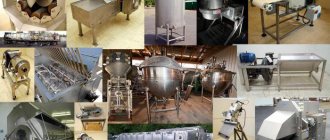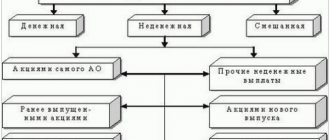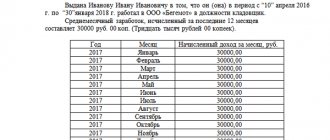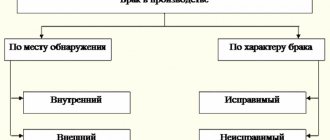Write-off of administrative and commercial expenses to cost price
Write-off of administrative and commercial expenses occurs through the 90th account as follows:
- Dt 90 subaccount “Administrative expenses” Kt 26;
- Dt 90 subaccount “Business expenses” Kt 44.
Let's dwell on the choice of method for writing off expenses from the 26th account.
An organization can choose and record in its accounting policy one of 2 methods of writing off to the following accounts:
- 20 (23, 29);
- 90.
With method 1, general business expenses participate in the formation of the full cost of finished products, ending up in cost accounts in full at the end of the month. They can be distributed between main, auxiliary and service industries, as well as between types of products. In the future, from the 20th (23rd, 29th) account, these expenses will go to the finished product accounts and will be written off in proportion to the volume of products sold to the cost price.
With the 2nd method, the financial result includes the entire amount of general business expenses incurred during the month, without being distributed between the products sold and those remaining in the warehouse. The 2nd method makes it much easier to write off expenses from the 26th account, and also increases expenses, reducing profits. The organization must describe the choice of method for writing off general business expenses in its accounting policy.
The chart of accounts does not allow you to choose which account to write off sales expenses to - only to the 90th one. However, the organization can choose whether to write them off completely or partially. Partial write-off implies a monthly distribution between goods sold and those remaining in the warehouse:
- for manufacturing companies - packaging and delivery costs;
- for trading companies - delivery costs.
Other items of selling expenses are written off in full.
Read about the distribution of delivery costs in the article “How to correctly calculate transport costs (nuances)?”
What subaccounts are used 90 accounts
The chart of accounts assumes the opening of the following 90 subaccounts on the account:
- 90/1 “Revenue” - it takes into account the main income of the company, which can be represented either by sales proceeds, rent, interest, if these types of activities are recognized as main ones.
- 90/2 “Expenses” - expenses incurred, as a result of which the company received income, are reflected. For example, the cost of finished products, works, services.
- 90/3 “VAT” – information is reflected on accrued (outgoing) VAT, which is included in the cost of goods, works, and services sold according to issued invoices.
- 90/4 “Excise taxes” – information on accrued excise taxes on products is reflected in accordance with current legislation. These amounts are also included as a surcharge in the price of the goods.
- 90/5 “Export duties” - used in foreign economic activity to reflect the duties included in the price.
- 90/6 “General business expenses” - applies when the organization’s accounting policy determines the method of writing off these expenses directly to cost, without first distributing them by type of activity. Here, management costs for services provided, work performed, and products sold are recorded.
- 90/7 “Commercial expenses” - used to summarize information on sales expenses for goods sold, works of services. This subaccount is used in trade organizations.
- 90/9 “Profit (loss) from the main activity” – is intended to reflect information on the formation of interim financial results for the type of activity being carried out. The turnover of account 90 is compared monthly or quarterly in order to determine interim financial results.
In accordance with the specifics of the activity being carried out, other sub-accounts may be opened for this account. This point is recorded in the accounting policy of the organization.
In addition, analytical accounting is opened on these sub-accounts for each type of product produced, services provided, and work performed.
Analytics can also be organized by sales regions or other areas that are required to manage the organization and make timely decisions.
Important! At the end of the year, account 90 is closed, which involves writing off the accumulated amounts of turnover in the subaccounts of the account to account 90/9. Thus, the balance of account 90 at the end of the year will be zero.
Accounting for goods at sales prices
Organizations working with retail can keep records of goods at sales prices (clause 20 of FSBU 5/2019, until 01/01/2021 - clause 13 of PBU 5/01). With this method there are some features of reflecting cost. Let's look at them with an example.
Find out how to account for goods in accordance with FSBU 5/2019 from 2021 in the Ready-made solution from ConsultantPlus. Demo access to the system can be obtained for free.
Example
The store purchased 50 kg of one type of sweets at a price of 472 rubles. per kg, including VAT 20%. Goods are accounted for at sales prices. The selling price of sweets is 500 rubles. per kg. Let's assume that there were no leftovers of such candies at the beginning of the month.
Dt 41.1 Kt 60 - 20,000 rub. — sweets have arrived at purchase prices;
Dt 19 Kt 60 - 4,000 rub. — reflected incoming VAT;
Dt 41.2 Kt 41.1 — 20,000 rub. — candies sold at retail;
Dt 41.2 Kt 42 - 5,000 rub. (500 × 50 – 20,000) - reflects the trade margin.
Within a month, all the candies were sold:
Dt 50 Kt 90.1 - 25,000 rub. — revenue is reflected;
Dt 90.3 Kt 68 - 5,000 rub. — VAT is charged on the sale;
Dt 90.2 Kt 41.2 - 25,000 rub. — the cost of sweets is written off at sales prices;
Reversal Dt 90.2 Kt 42 - 5,000 rub. — the trade margin has been written off.
Check whether you are taking into account the financial result correctly, with the help of explanations from ConsultantPlus experts. If you do not have access to the K+ system, get a trial online access for free.
Account characteristics
To generate data on income received, as well as expenses incurred for the normal activities of a business entity, account 90 is used.
This account differs from many others in that it has no balance at the beginning or end of the reporting period. In addition, the account is active-passive, since during interim summing up it can contain both a debit and a credit balance.
Account 90 records income and expenses for the following types of activities:
- For the sale of any finished product;
- For work and services performed in various areas;
- For purchased products that are included in the packaging of finished products;
- To account for work related to construction or installation;
- For transportation services;
- For loading and unloading services;
- When renting out your property, if this is the main source of income;
- When transferring rights to patents on a paid basis.
The debit of account 90 reflects the entire range of costs incurred for core activities. The amounts of cost, accrued taxes, etc. are indicated here. Credit 90 of the account reflects the entire volume of revenue received from the main activity.
Attention! Account 90 is closed by generating the amount of profit or loss using account 90 09, and then writing it off to account 99. Since this account should not have a balance at the end of the period, it is not reflected in the balance sheet.
Determination of financial results for core activities
Postings to subaccounts of the 90th account are made throughout the year, accumulating the amounts of income and expenses. This approach makes it easy to generate the appropriate lines in the income statement. To obtain information about the organization's performance for the month, the accountant calculates expenses (turnover on the debit of the 90th account) and income (turnover on the credit of the 90th account). The difference between these values is profit or loss for the month; this value is reflected by posting Dt 90.9 Kt 99 when making a profit or Dt 99 Kt 90.9 when receiving a loss.
As a result, by the end of the year, a final balance will be formed on all subaccounts used by the organization, which must be reset to zero. For subaccounts with a debit balance, an entry for its full amount is made on the credit of this subaccount and the debit of subaccount 90.9, for subaccounts with a credit balance - vice versa:
Dt 90.1 Kt 90.9
Dt 90.9 Kt 90.2
Dt 90.9 Kt 90.3, etc.
Sales analysis is one of the main aspects that must be taken into account when developing an organization's marketing policy. Therefore, it is important to set up the correct analytics for account 90. Most often, sales analysis is carried out by type of product, by geographic location, by counterparty, by structural division of the organization, etc. Analytical accounting is organized depending on the needs of users for accounting information.
Examples of transactions using 90 accounts
Example 1
Artel Group LLC sold two batches of goods in May 2021. The cost of the 1st batch amounted to 90,000.00 rubles, revenue - 130,000.00 rubles. The cost of the 2nd batch was 96,000.00 rubles, the revenue amounted to 148,000.00 rubles. VAT accrued for the 1st batch - 19,830.42 rubles, for the 2nd batch - 22,576.27 rubles.
We calculate the sales result for the month: credit turnover (revenue), 130,000 + 148,000 minus debit turnover (VAT + cost), 19,830.42 + 22,576.27 + 90,000 + 96,000, it turns out 49,593.31 rubles.
The following entries were made for account 90 to reflect the sales results of Artel Group:
| Dt | CT | Operation description | Amount, rub. | Document |
| 62 | 90.1 | Reflection on the implementation of the 1st batch | 130 000,00 | Act |
| 90.3 | 68 | VAT accrual on sales | 19 830,42 | SF issued |
| 90.2 | 43 | Reflection of the cost of the 1st batch | 90 000,00 | Accounting information |
| 62 | 90.1 | Reflection of the implementation of the 2nd batch | 148 000,00 | Act |
| 90.3 | 68 | VAT calculation | 22 576,27 | SF issued |
| 90.2 | 43 | The cost of the 2nd batch is reflected | 96 000,00 | Accounting information |
| 90.9 | 99 | We reflect the sales result (profit) for May | 49 593,31 | Accounting information |
Results
Account 90 is necessary to collect data on income and expenses for activities that the company considers normal for itself.
Income is recorded on the credit side of the account, and expenses are recorded on the debit side. The company can independently enter subaccounts to the 90th account - depending on business conditions and the accounting data used. You can find more complete information on the topic in ConsultantPlus. Free trial access to the system for 2 days.
Accounting on account 90
As stated above, account 90 is intended to summarize information about income and expenses and compare them. The difference in using account 90 when generating accounting records will be whether a specific business transaction will be reflected in the debit or credit of this account.
So, revenue in accounting account 90 is reflected as a credit, and expenses - as a debit.
Therefore, when accounting recognizes revenue from the sale of goods, products, performance of work or provision of services, the posting is usually generated as follows:
Debit of account 62 “Settlements with buyers and customers” - Credit of account 90
At the same time, the cost of goods, works, and services sold is written off using the following accounting entries:
Debit of account 90 – Credit of accounts 20 “Main production”, 41 “Goods”, 43 “Finished products”, etc.
In addition, the debit of account 90 writes off expenses associated with the sale, as well as other costs attributed directly to the sales account. For example, general business expenses, which can be considered as semi-fixed in accordance with the accounting policies of the organization. Therefore, on the debit of account 90, the following entries may also be made:
Debit account 90 – Credit account 26 “General business expenses”, 44 “Sales expenses”
Analytical accounting on account 90 is maintained for each type of goods sold, products, work performed, services provided. Also, depending on the goals, analytical accounting can be maintained by sales regions and other areas.
Which accounts does account 90 correspond to?
The list of accounts with which account 90 can correspond is huge. This is due to the fact that most of the operations are aimed at making a profit in one way or another. In the table we have collected all possible correspondence options.
| By debit | By loan |
| 11 “Animals for growing and fattening” 20 “Main production” 21 “Semi-finished products of own production” 23 “Auxiliary production” 26 “General expenses” 29 “Service production and farms” 40 “Product output” 41 “Goods” 42 “Trade margin” 43 “Finished products” 44 “Sales expenses” 45 “Shipped goods” 58 “Financial investments” 68 “Calculations for taxes and duties” 79 “Intra-business operations” 99 “Profit and losses” | 46 “Completed stages of work in progress” 50 “Cash desk” 51 “Currency account” 52 “Currency accounts” 57 “Transfers in transit” 62 “Settlements with buyers and customers” 76 “Settlements with various debtors and creditors” 79 “Intra-business settlements” 98 “Deferred income” 99 “Profit and losses” |
Basic operations with a score of 90
Operations involving account 90 are related to the sale of goods or services. Here it is very important to use the subaccounts that we described above.
| Debit | Credit | The essence of the operation |
| 62 | 90.1 | Revenues from sales |
| 90.2 | 43, 41 | The cost of manufactured products or goods for resale is determined |
| 90.3 | 68 | VAT charged on the sale price |
| 90.8 | 26 | Administrative expenses written off |
| 90.7 | 44 | Business expenses written off |
| 99 | 90.9 | The loss from the sale is reflected (if the debit turnover is 90, less than the credit turnover) |
| 90.9 | 99 | The profit from the sale is reflected (if the debit turnover is 90 more than the credit turnover) |
We recommend you the cloud service Kontur.Accounting. In our program, you can keep track of income and expenses by subaccounts, areas of activity, product groups, and so on. We give new users a free trial period of 14 days.









